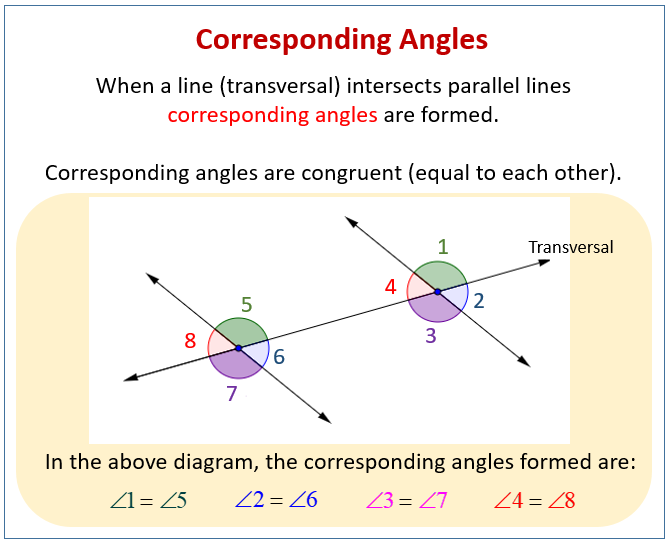Angles & Parallel Lines in Geometry
Related Topics:
More Lessons for High School Geometry
Math Worksheets
A series of free, online High School Geometry Video Lessons and solutions.
Examples, solutions, videos, worksheets, and activities to help Geometry students.
Angles & Parallel Lines
When discussing angles in geometry, the relationship between angles and parallel lines is a very important concept.
- Parallel Lines: Parallel lines are lines that lie in the same plane and never intersect, no matter how far they are extended.
- Transversal: A transversal is a line that intersects two or more other lines. When a transversal intersects parallel lines, it creates several angle relationships.
Angle Relationships:
When a transversal intersects two parallel lines, specific angle pairs are formed, and these pairs have special relationships:
- Corresponding Angles:
These angles are in the same relative position at each intersection.
When the lines are parallel, corresponding angles are congruent (equal in measure). - Alternate Interior Angles: These angles are on opposite sides of the transversal and inside the parallel lines. When the lines are parallel, alternate interior angles are congruent.
- Alternate Exterior Angles: These angles are on opposite sides of the transversal and outside the parallel lines. When the lines are parallel, alternate exterior angles are congruent.
- Same-Side Interior Angles (Consecutive Interior Angles): These angles are on the same side of the transversal and inside the parallel lines. When the lines are parallel, same-side interior angles are supplementary (their measures add up to 180 degrees).
The following diagram gives some examples of corresponding angles. Scroll down the page for more examples and solutions.

Adjacent Angles
Adjacent angles share a side and a vertex. If angles only share a side but not a vertex, they are not adjacent. Adjacent angles can also be described as “next to” or “side-by-side” angles.
How to define adjacent angles and define a linear pair.
Definition of adjacent angles
Vertical Angles
Vertical angles always come in pairs. They share a common vertex but they cannot share a side. Vertical angles are congruent, which means they have equal measures.
How to define and identify vertical angles.
How to find a missing vertical angle in a triangle?
Corresponding Angles
Corresponding angles can apply to either two polygons or parallel lines cut by a transversal. In both cases, corresponding angles are in the same position. If the two polygons are congruent, then the corresponding angles are also congruent. If the two lines are parallel, then the corresponding angles created by the transversal are congruent.
How to define corresponding angles and their special properties.
This video describes corresponding angles
Try out our new and fun Fraction Concoction Game.
Add and subtract fractions to make exciting fraction concoctions following a recipe. There are four levels of difficulty: Easy, medium, hard and insane. Practice the basics of fraction addition and subtraction or challenge yourself with the insane level.

We welcome your feedback, comments and questions about this site or page. Please submit your feedback or enquiries via our Feedback page.